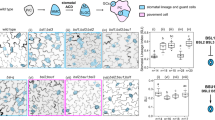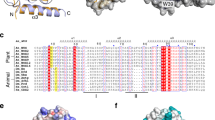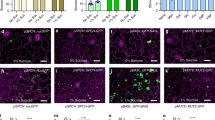Abstract
Cell fate in eukaryotes is controlled by mitogen-activated protein kinases (MAPKs) that translate external cues into cellular responses. In plants, two MAPKs—MPK3 and MPK6—regulate diverse processes of development, environmental response and immunity. However, the mechanism that bridges these shared signalling components with a specific target remains unresolved. Focusing on the development of stomata—epidermal valves that are essential for gas exchange and transpiration—here, we report that the basic helix-loop-helix protein SCREAM functions as a scaffold that recruits MPK3/6 to downregulate SPEECHLESS, a transcription factor that initiates stomatal cell lineages. SCREAM directly binds to MPK3/6 through an evolutionarily conserved, yet unconventional, bipartite motif. Mutations in this motif abrogate association, phosphorylation and degradation of SCREAM, unmask hidden non-redundancies between MPK3 and MPK6, and result in uncontrolled stomatal differentiation. Structural analyses of MPK6 with a resolution of 2.75 Å showed bipartite binding of SCREAM to MPK6 that is distinct from an upstream MAPKK. Our findings elucidate, at the atomic resolution, the mechanism that directly links extrinsic signals to transcriptional reprogramming during the establishment of stomatal cell fate, and highlight a unique substrate-binding mode adopted by plant MAPKs.
This is a preview of subscription content, access via your institution
Access options
Access Nature and 54 other Nature Portfolio journals
Get Nature+, our best-value online-access subscription
$29.99 / 30 days
cancel any time
Subscribe to this journal
Receive 12 digital issues and online access to articles
$119.00 per year
only $9.92 per issue
Buy this article
- Purchase on Springer Link
- Instant access to full article PDF
Prices may be subject to local taxes which are calculated during checkout






Similar content being viewed by others
Data availability
The PDB accession number for the MPK6ΔNt structure reported in this paper is 6DTL. All data generated and/or analysed during the current study are available from the corresponding authors on reasonable request.
References
Pitzschke, A. Modes of MAPK substrate recognition and control. Trends Plant Sci. 20, 49–55 (2015).
Meng, X. & Zhang, S. MAPK cascades in plant disease resistance signaling. Annu. Rev. Phytopathol. 51, 245–266 (2013).
Tena, G., Boudsocq, M. & Sheen, J. Protein kinase signaling networks in plant innate immunity. Curr. Opin. Plant Biol. 14, 519–529 (2011).
Xu, J. & Zhang, S. Mitogen-activated protein kinase cascades in signaling plant growth and development. Trends Plant Sci. 20, 56–64 (2015).
Colcombet, J. & Hirt, H. Arabidopsis MAPKs: a complex signalling network involved in multiple biological processes. Biochem. J. 413, 217–226 (2008).
Meng, X. et al. A MAPK cascade downstream of ERECTA receptor-like protein kinase regulates Arabidopsis inflorescence architecture by promoting localized cell proliferation. Plant Cell 24, 4948–4960 (2012).
Wang, H. et al. Haplo-insufficiency of MPK3 in MPK6 mutant background uncovers a novel function of these two MAPKs in Arabidopsis ovule development. Plant Cell 20, 602–613 (2008).
Hord, C. L. et al. Regulation of Arabidopsis early anther development by the mitogen-activated protein kinases, MPK3 and MPK6, and the ERECTA and related receptor-like kinases. Mol. Plant 1, 645–658 (2008).
Bush, S. M. & Krysan, P. J. Mutational evidence that the Arabidopsis MAP kinase MPK6 is involved in anther, inflorescence, and embryo development. J. Exp. Bot. 58, 2181–2191 (2007).
Wang, H. C., Ngwenyama, N., Liu, Y. D., Walker, J. C. & Zhang, S. Q. Stomatal development and patterning are regulated by environmentally responsive mitogen-activated protein kinases in Arabidopsis. Plant Cell 19, 63–73 (2007).
Wang, B. et al. Analysis of crystal structure of Arabidopsis MPK6 and generation of its mutants with higher activity. Sci. Rep. 6, e25646 (2016).
Qi, X. & Torii, K. U. Hormonal and environmental signals guiding stomatal development. BMC Biol. 16, 21 (2018).
Pillitteri, L. J. & Dong, J. Stomatal development in Arabidopsis. Arabid. Book 11, e0162 (2013).
Lee, J. S. et al. Direct interaction of ligand-receptor pairs specifying stomatal patterning. Genes Dev. 26, 126–136 (2012).
Lee, J. S. et al. Competitive binding of antagonistic peptides fine-tunes stomatal patterning. Nature 522, 439–443 (2015).
Bergmann, D. C., Lukowitz, W. & Somerville, C. R. Stomatal development and pattern controlled by a MAPKK kinase. Science 304, 1494–1497 (2004).
Lampard, G. R., MacAlister, C. A. & Bergmann, D. C. Arabidopsis stomatal initiation is controlled by MAPK-mediated regulation of the bHLH SPEECHLESS. Science 322, 1113–1116 (2008).
Zhang, Y., Wang, P., Shao, W., Zhu, J. K. & Dong, J. The BASL polarity protein controls a MAPK signaling feedback loop in asymmetric cell division. Dev. Cell 33, 136–149 (2015).
Zhang, Y., Guo, X. & Dong, J. Phosphorylation of the polarity protein BASL differentiates asymmetric cell fate through MAPKs and SPCH. Curr. Biol. 26, 2957–2965 (2016).
Dong, J., MacAlister, C. A. & Bergmann, D. C. BASL controls asymmetric cell division in Arabidopsis. Cell 137, 1320–1330 (2009).
Kanaoka, M. M. et al. SCREAM/ICE1 and SCREAM2 specify three cell-state transitional steps leading to Arabidopsis stomatal differentiation. Plant Cell 20, 1775–1785 (2008).
Pillitteri, L. J., Sloan, D. B., Bogenschutz, N. L. & Torii, K. U. Termination of asymmetric cell division and differentiation of stomata. Nature 445, 501–505 (2007).
Horst, R. J. et al. Molecular framework of a regulatory circuit initiating two-dimensional spatial patterning of stomatal lineage. PLoS Genet. 11, e1005374 (2015).
Walter, M. et al. Visualization of protein interactions in living plant cells using bimolecular fluorescence complementation. Plant J. 40, 428–438 (2004).
Qu, X., Peterson, K. M. & Torii, K. U. Stomatal development in time: the past and the future. Curr. Opin. Genet. Dev. 45, 1–9 (2017).
Abdiche, Y., Malashock, D., Pinkerton, A. & Pons, J. Determining kinetics and affinities of protein interactions using a parallel real-time label-free biosensor, the Octet. Anal. Biochem. 377, 209–217 (2008).
Tanoue, T., Adachi, M., Moriguchi, T. & Nishida, E. A conserved docking motif in MAP kinases common to substrates, activators and regulators. Nat. Cell Biol. 2, 110–116 (2000).
Garai, A. et al. Specificity of linear motifs that bind to a common mitogen-activated protein kinase docking groove. Sci. Signal. 5, RA74 (2012).
Zeke, A. et al. Systematic discovery of linear binding motifs targeting an ancient protein interaction surface on MAP kinases. Mol. Syst. Biol. 11, 837 (2015).
Lee, J. S., Huh, K. W., Bhargava, A. & Ellis, B. E. Comprehensive analysis of protein-protein interactions between Arabidopsis MAPKs and MAPK kinases helps define potential MAPK signalling modules. Plant Signal. Behav. 3, 1037–1041 (2008).
Li, H. et al. MPK3-and MPK6-mediated ICE1 phosphorylation negatively regulates ICE1 stability and freezing tolerance in Arabidopsis. Dev. Cell 43, 630–642 (2017).
Zhao, C. Z. et al. MAP kinase cascades regulate the cold response by modulating ICE1 protein stability. Dev. Cell 43, 618–629 (2017).
Yang, K. Y., Liu, Y. & Zhang, S. Activation of a mitogen-activated protein kinase pathway is involved in disease resistance in tobacco. Proc. Natl Acad. Sci. USA 98, 741–746 (2001).
Raissig, M. T., Abrash, E., Bettadapur, A., Vogel, J. P. & Bergmann, D. C. Grasses use an alternatively wired bHLH transcription factor network to establish stomatal identity. Proc. Natl Acad. Sci. USA 113, 8326–8331 (2016).
Dong, C. H., Agarwal, M., Zhang, Y., Xie, Q. & Zhu, J. K. The negative regulator of plant cold responses, HOS1, is a RING E3 ligase that mediates the ubiquitination and degradation of ICE1. Proc. Natl Acad. Sci. USA 103, 8281–8286 (2006).
Miura, K. et al. SIZ1-mediated sumoylation of ICE1 controls CBF3/DREB1A expression and freezing tolerance in Arabidopsis. Plant Cell 19, 1403–1414 (2007).
Ding, Y. et al. OST1 kinase modulates freezing tolerance by enhancing ICE1 stability in Arabidopsis. Dev. Cell 32, 278–289 (2015).
Lee, J. H., Jung, J. H. & Park, C. M. Light inhibits COP1-mediated degradation of ICE transcription factors to induce stomatal development in Arabidopsis. Plant Cell 29, 2817–2830 (2017).
Lee, J. H., Jung, J. H. & Park, C. M. Inducer of cbf expression 1 integrates cold signals into FLOWERING LOCUS C-mediated flowering pathways in Arabidopsis. Plant J. 84, 29–40 (2015).
Chinnusamy, V. et al. ICE1: a regulator of cold-induced transcriptome and freezing tolerance in Arabidopsis. Genes Dev. 17, 1043–1054 (2003).
Denay, G. et al. Endosperm breakdown in Arabidopsis requires heterodimers of the basic helix-loop-helix proteins ZHOUPI and INDUCER OF CBP EXPRESSION 1. Development 141, 1222–1227 (2014).
Tanoue, T. & Nishida, E. Molecular recognitions in the MAP kinase cascades. Cell. Signal. 15, 455–462 (2003).
Schweighofer, A. et al. The PP2C-type phosphatase AP2C1, which negatively regulates MPK4 and MPK6, modulates innate immunity, jasmonic acid, and ethylene levels in Arabidopsis. Plant Cell 19, 2213–2224 (2007).
Pillitteri, L. J., Peterson, K. M., Horst, R. J. & Torii, K. U. Molecular profiling of stomatal meristemoids reveals new component of asymmetric cell division and commonalities among stem cell populations in Arabidopsis. Plant Cell 23, 3260–3275 (2011).
Houbaert, A. et al. POLAR-guided signalling complex assembly and localization drive asymmetric cell division. Nature 563, 574–578 (2018).
Clough, S. J. & Bent, A. F. Floral dip: a simplified method for Agrobacterium-mediated transformation of Arabidopsis thaliana. Plant J. 16, 735–743 (1998).
Vojtek, A. B. & Hollenberg, S. M. Ras-Raf interaction: two-hybrid analysis. Methods Enzymol. 255, 331–342 (1995).
Bartel, P. L., Chien, C.-T., Sternglanz, R. & Fields, S. in Cellular Interactions in Development: A Practical Approach (Ed. Hartley, D. A.) 153–179 (Oxford Univ. Press, 1993).
FromontRacine, M., Rain, J. C. & Legrain, P. Toward a functional analysis of the yeast genome through exhaustive two-hybrid screens. Nat. Genet. 16, 277–282 (1997).
Formstecher, E. et al. Protein interaction mapping: a Drosophila case study. Genome Res. 15, 376–384 (2005).
Qi, X. Autocrine regulation of stomatal differentiation potential by EPF1 and ERECTA-LIKE1 ligand-receptor signaling. eLife 6, e24102 (2017).
Otwinowski, Z. & Minor, W. Processing of X-ray diffraction data collected in oscillation mode. Methods Enzymol. 276, 307–326 (1997).
McCoy, A. J. et al. Phaser crystallographic software. J. Appl. Crystallogr. 40, 658–674 (2007).
Emsley, P., Lohkamp, B., ScottW. G. & Cowtan, K. Features and development of Coot. Acta Crystallogr 66, 486–501 (2010).
Adams, P. D. et al. PHENIX: a comprehensive Python-based system for macromolecular structure solution. Acta Crystallogr. 66, 213–221 (2010).
Sali, A. & Blundell, T. L. Comparative protein modeling by satisfaction of spatial restraints. J. Mol. Biol. 234, 779–815 (1993).
Raveh, B., London, N., Zimmerman, L. & Schueler-Furman, O. Rosetta FlexPepDock ab-initio: simultaneous folding, docking and refinement of peptides onto their receptors. PLoS ONE 6, e18934 (2011).
Simons, K. T., Bonneau, R., Ruczinski, I. & Baker, D. Ab initio protein structure prediction of CASP III targets using ROSETTA. Proteins 3, 171–176 (1999).
Leaver-Fay, A. et al. ROSETTA3: An object-oriented software suite for the simulation and design of macromolecules. Methods Enzymol. 487, 545–574 (2011).
Pettersen, E. F. et al. UCSF Chimera—A visualization system for exploratory research and analysis. J. Comput. Chem. 25, 1605–1612 (2004).
Sanner, M. F., Olson, A. J. & Spehner, J. C. Reduced surface: an efficient way to compute molecular surfaces. Biopolymers 38, 305–320 (1996).
Acknowledgements
We thank S. Zhang for his gifts of Arabidopsis mpk3, mpk6 and inducible NtMEK2DD overexpression line, J. Dong for thoughtful discussions and T. Hinds for helping to set up the in vitro interaction assays using the Octet system. This work was supported by the US National Science Foundation (MCB-0855659) and the Gordon and Betty Moore Foundation (GBMF-3035) to K.U.T., and Grants in Aid for Scientific Research on Innovative Areas (17H06476), Japan Society for Promotion of Sciences (JSPS) (26119006 and 15K21711) to F.T. N.Z. and K.U.T. are Howard Hughes Medical Institute (HHMI) Investigators.
Author information
Authors and Affiliations
Contributions
K.U.T. conceived the project; A.P. and K.U.T. conceptualized the study; A.P., A.L.R., N.Z. and K.U.T. designed the experiments; A.P., J.R., C.Z., A.L.R., A.K.H. and X.T. performed the experiments; J.R., A.S., F.T. and N.Z. performed the structural analysis and modelling; A.P., J.R., A.S., A.L.R., N.Z. and K.U.T. carried out the formal analysis; A.P., J.R., A.S. and K.U.T. visualized the data; A.P. and K.U.T wrote the original draft; A.P., J.R., A.S., C.Z., A.L.R., A.K.H, F.T., N.Z. and K.U.T reviewed and edited the paper; N.Z. and K.U.T. supervised the project; K.U.T. oversaw project administration; and J.-K.Z., F.T., N.Z. and K.U.T acquired funding.
Corresponding authors
Ethics declarations
Competing interests
The authors declare no competing interests.
Additional information
Peer review information: Nature Plants thanks Laszlo Bogre, Shuqun Zhang and the other, anonymous, reviewer(s) for their contribution to the peer review of this work.
Publisher’s note: Springer Nature remains neutral with regard to jurisdictional claims in published maps and institutional affiliations.
Supplementary information
Supplementary Information
Supplementary Figs. 1–8 and Supplementary Table 2.
Supplementary Table 1
Y2H screen and interactors.
Supplementary Table 3
List of plasmids and primers.
Supplementary Table 4
Raw data of individual BLI experiments.
Supplementary Table 5
Exact P values for statistical analysis.
Rights and permissions
About this article
Cite this article
Putarjunan, A., Ruble, J., Srivastava, A. et al. Bipartite anchoring of SCREAM enforces stomatal initiation by coupling MAP kinases to SPEECHLESS. Nat. Plants 5, 742–754 (2019). https://doi.org/10.1038/s41477-019-0440-x
Received:
Accepted:
Published:
Issue Date:
DOI: https://doi.org/10.1038/s41477-019-0440-x
This article is cited by
-
Dichotomy of the BSL phosphatase signaling spatially regulates MAPK components in stomatal fate determination
Nature Communications (2022)
-
Light regulates stomatal development by modulating paracrine signaling from inner tissues
Nature Communications (2021)
-
SCREAM in the making of stomata
Nature Plants (2019)



